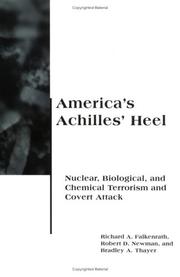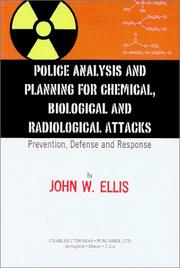| Listing 1 - 10 of 179 | << page >> |
Sort by
|
Book
ISBN: 0674003942 Year: 2001 Publisher: Cambridge (Mass.) Harvard University Press
Abstract | Keywords | Export | Availability | Bookmark
 Loading...
Loading...Choose an application
- Reference Manager
- EndNote
- RefWorks (Direct export to RefWorks)
Book
ISBN: 9798216163886 1440855757 9781440855757 9781440855740 1440855749 Year: 2018 Publisher: Santa Barbara, California
Abstract | Keywords | Export | Availability | Bookmark
 Loading...
Loading...Choose an application
- Reference Manager
- EndNote
- RefWorks (Direct export to RefWorks)
This book offers an A-to-Z listing of major topics, with a focus on weapons that date from the use of chemical warfare in World War I. It also covers WMD from the early nuclear era (World War II), the Cold War, and the present (Syria, North Korea, etc.). Each entry is written in a clear, accessible style and includes crucial background information.
Book
ISBN: 1538106841 9781538106846 9781538106839 Year: 2017 Publisher: Lanham, MD
Abstract | Keywords | Export | Availability | Bookmark
 Loading...
Loading...Choose an application
- Reference Manager
- EndNote
- RefWorks (Direct export to RefWorks)
"This second edition of Historical Dictionary of Nuclear, Biological and Chemical Warfare contains a chronology, an introduction, and an extensive bibliography. It has more than 700 cross-referenced entries on terms related to nuclear, biological and chemical warfare."--Provided by publisher.
Book
ISBN: 1442273313 9781442273313 9781442273290 9781442273306 1442273291 Year: 2016 Publisher: Lanham
Abstract | Keywords | Export | Availability | Bookmark
 Loading...
Loading...Choose an application
- Reference Manager
- EndNote
- RefWorks (Direct export to RefWorks)
Book
ISBN: 0804772053 9780804772051 9780804763608 0804763607 Year: 2009 Publisher: Stanford, Calif. Stanford University Press
Abstract | Keywords | Export | Availability | Bookmark
 Loading...
Loading...Choose an application
- Reference Manager
- EndNote
- RefWorks (Direct export to RefWorks)
This book explains the challenge of monitoring small clandestine WMD programs, how the effort to monitor and prevent terrorist acquisition and use of WMD differs from monitoring and preventing the acquisition and use of WMD by nation states, and puts the Iraqi WMD issue in proper perspective.
Intelligence service --- Weapons of mass destruction --- Nuclear nonproliferation --- Government policy
Book
ISBN: 1350987522 1786732645 178672264X 9781786722645 9781350987524 178453885X 9781784538859 Year: 2018 Publisher: London
Abstract | Keywords | Export | Availability | Bookmark
 Loading...
Loading...Choose an application
- Reference Manager
- EndNote
- RefWorks (Direct export to RefWorks)
"Concerns about CBRN (Chemical, Biological, Radioactive, Nuclear) weapons have featured prominently in both political debates and media reporting about the ongoing threat from al Qaeda since 9/11. This book provides a chronological account of al Qaeda's efforts to acquire a CBRN weapon capability, and the evolution of the al Qaeda leadership's approach to actually using CBRN weapons, set against the context of the politicisation of the threat of CBRN terrorism in US security debates. Ben Cole explores how the inherently political nature of terrorist CBRN threats has helped to shape al Qaeda's approach to CBRN weapons, and shows how the heightened political sensitivities surrounding the threat have enabled some governments to manipulate it in order to generate domestic and international support for controversial policies, particularly the 2003 invasion of Iraq. He assesses the relative success of the al Qaeda leadership's political approach to CBRN weapons, together with the relative success of efforts by the US, UK and Russian governments to exploit the al Qaeda CBRN threat for their wider political purposes. Shedding new light on al Qaeda's tactics and strategy, this book will be essential reading for scholars of terrorism and extremism studies."--Bloomsbury Publishing.
National security. --- Terrorism. --- Weapons of mass destruction. --- Qaida (Organization)
Book
ISBN: 1283130289 9786613130280 0199770964 0197721133 9780199770960 9781283130288 6613130281 9780195389265 0195389263 Year: 2010 Publisher: Oxford [UK] New York Oxford University Press
Abstract | Keywords | Export | Availability | Bookmark
 Loading...
Loading...Choose an application
- Reference Manager
- EndNote
- RefWorks (Direct export to RefWorks)
'Verification in an Age of Insecurity' takes the reader into some of the most urgent arms control issues facing the world community, including the nuclear activities of rogue states and threats from sophisticated non-state actors. In the book, national security expert Philip D. O'Neill, Jr. identifies and addresses issues from the resuscitated disarmament agenda, from the comprehensive test ban to fissile material and biological weapons. O'Neill examines the need for shifts in verification standards and policy suitable for our volatile era and beyond it. He surveys recent history to show how established verification procedures fail to produce the certainty necessary to meet today's threats.

ISBN: 0262561182 9780262561181 Year: 1998 Publisher: Cambridge, Mass.: MIT Press,
Abstract | Keywords | Export | Availability | Bookmark
 Loading...
Loading...Choose an application
- Reference Manager
- EndNote
- RefWorks (Direct export to RefWorks)
Book
ISBN: 9783031218200 Year: 2023 Publisher: Cham, Switzerland : Springer,
Abstract | Keywords | Export | Availability | Bookmark
 Loading...
Loading...Choose an application
- Reference Manager
- EndNote
- RefWorks (Direct export to RefWorks)
Biological weapons. --- Bacteriological weapons --- Biological warfare agents --- Bioweapons --- Weapons of mass destruction --- Biosecurity

ISBN: 0398083401 9780398083403 0398069816 0398069824 Year: 1999 Publisher: Springfield, Illinois : Charles C Thomas Publisher, Ltd.,
Abstract | Keywords | Export | Availability | Bookmark
 Loading...
Loading...Choose an application
- Reference Manager
- EndNote
- RefWorks (Direct export to RefWorks)
This text is oriented toward planning police operations in the public sector, but will be usable by other public officials as well as some private sector police operations. It addresses police threat assessment of, vulnerability assessment to, defense against and response to attacks by special weapons of mass destruction in a civilian setting. These include chemical, biological and radiological attacks. It begins with a review of the policy and legal issues pertaining to special weapons and of the pertinent counter-terrorist response considerations discussed in the author's other book, POLICE
Police --- Terrorism --- Weapons of mass destruction. --- Biological weapons. --- Chemical weapons. --- Special weapons and tactics units. --- Prevention.
| Listing 1 - 10 of 179 | << page >> |
Sort by
|

 Search
Search Feedback
Feedback About UniCat
About UniCat  Help
Help News
News